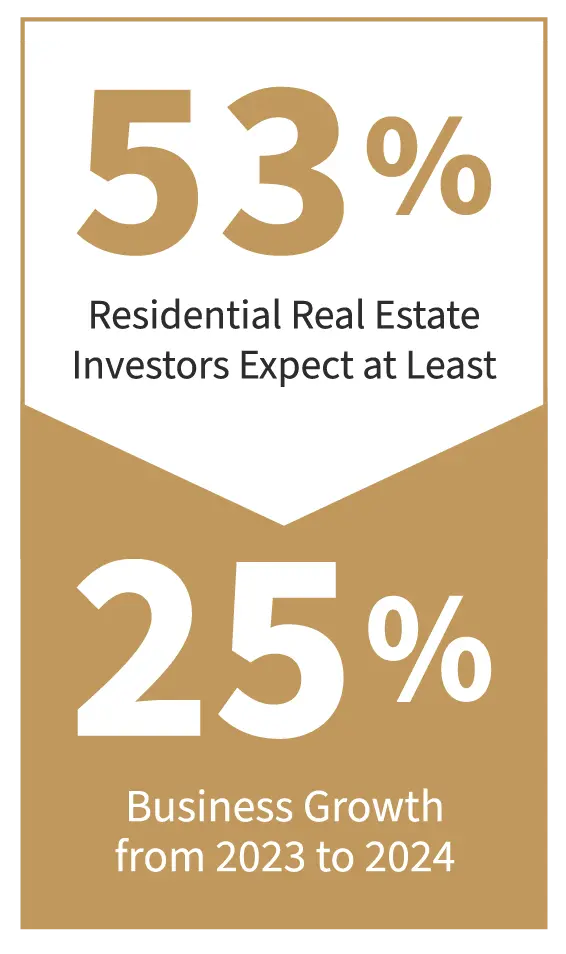


This report is an analysis of insights based on New Western market sales data and opinion polling from October to November 2023 of 1,280 real estate investors.
New Western surveyed investors ages 18+ who have previously purchased property through its marketplace or plan to in the future.
Additionally, an external survey was conducted during the same time frame among consumers who are looking for a new home from Gutcheck, a global market research company. The external survey includes over 820 participants ages 18+ who have considered purchasing a house in the last 12 months or who have purchased one.

The prevalent themes from the end of 2022 extended into 2023 and remain consistent.

In December 2022 there was 2.6 months supply of homes compared to 2.7 months supply in November 2023.

From December 2022 to November 2023 inventory has risen 7% from 996,500 homes to 1,066,111.

Mortgage rates have made historic surges and reached their highest level since the year 2000. The 30-year fixed rate was 3.22% in January 2022 and 7.76% in November 2023.

Affordability is rare for families in the middle-income range with nearly 51% of households earning $75,000 or less, leaving them to afford approximately 23% of listings.
In this report, we reveal how single-family investors are still growing their business even in contrast to the stagnant traditional real estate market. We also dive into how investors provide opportunities for homebuyers in need of options.

In a survey of 820 consumers who have considered purchasing a house in the last 12 months, 79% have not yet purchased a home.
A little over half of those consumers, who have not purchased a home yet, are worried about finding a home in the next year, though they remain optimistic.

As we enter the new year with continued low inventory, local investors are providing solutions to the shortage as consumers look for housing options. Many of the investors we work with at New Western are taking uninhabitable homes, fixing them and making them livable again. These investors are fueled by the opportunity to capitalize while delivering much-needed residential properties back to the market.


Most investors today are solopreneurs or local small businesses who are more adept at fixing and flipping in their back yard than larger institutional investors.



Investors are using investor loans and cash almost equally to fund deals.
And not surprisingly, investors continue to hear that the TOP PRIORITY for their buyers is LOCATION and NEIGHBORHOOD.

The Fed’s stated goal of ‘higher for longer’ interest rates will keep supply muted relative to history, but we’ve already passed the point of peak ‘lock-in’ effect, and we suspect that more buyers and sellers will let go of the hope for significantly lower rates as time goes on. Flippers will continue to be a particularly important source of housing supply in markets where new home construction is limited and current homeowners cling to their low mortgage rates as long as possible.

Houston, TX
Investor activity up 32% from first half 2023 to second half 2023
Traditional home sales* are down 31%

Raleigh, NC
Investor activity up 27% from first half 2023 to second half 2023
Traditional home sales* are down 35%

Atlanta, GA
Investor activity up 23% from first half 2023 to second half 2023
Traditional home sales* are down 33%

Denver, CO
Investor activity up 14% from first half 2023 to second half 2023
Traditional home sales* are down 32%

Austin, TX
Investor activity up 12% from first half 2023 to second half 2023
Traditional home sales* are down 33%

of investors say that their completed flips are selling at or above the asking price, which is still below the median in most markets.
Investors are primarily buying vacant homes in active markets, creating more affordable inventory and adding new stock to the market.

Houston, TX
$197,555

Raleigh, NC
$150,000

Atlanta, GA
$190,000

Denver, CO
$375,000

Austin, TX
$247,000

Houston, TX
$333,000

Raleigh, NC
$326,246

Atlanta, GA
$386,500

Denver, CO
$580,000

Austin, TX
$455,000
Just like the traditional market, not all investor markets are experiencing an uptick in activity.

Kansas City, MO

Philadelphia, PA

Tampa, FL
From 2022 to the end of 2023 the trend remains the same with investors split by



And an interesting development in 2023 is a rise in female investors who are Boomers.
Gen X men are the #1 age group dominating the rehab space.

Women tend to buy in lower volumes than men, with 91% buying primarily 1-5 properties per year.
78% of male investors purchase 1-5 properties per year and 14% purchase 6-10 annually.
Millennial investors continue to grow and remain just behind Gen X investors in the generational breakdown.

Despite affordability challenges, the lack of resale inventory continues to provide market support for builders.
2023 kicked off with the U.S. lacking 5 million homes and the NAHB expecting 830,000 builds to be complete. Additionally, investors are expected to fix and flip 360,000 homes this year, many of which were either vacant or uninhabitable.

Homebuyers remain optimistic that housing inventory will become available in 2024. With data pointing to improving conditions for home construction in the coming months, paired with a rise in local investor activity, we should begin to see the gap shrinking between supply and demand. Further, NAHB is forecasting approximately a 5% increase for singlefamily starts in 2024 as financial conditions ease with improving inflation data in the months ahead.

The housing market moves fast with where the bond market goes. As mortgage rates headed up toward 8%, the market did slow down, but not as much as we saw last year. The inventory growth was slower, and the year-over-year price growth % was still below 2022 levels even when mortgage rates got toward 8%. Now that the mortgage rates have fallen almost 1% from the highs, we have already seen demand pick up from the low levels, similar to what happened at the end of last year.

The steady beat of, what we like to call, The Great Renovation will continue into 2024. The prime remodel years for homes will rise into 2027, with 24 million homes ripe for major renovation. This widens opportunity for the fix-andflip investor because existing inventory will absolutely require major renovations that homeowners have not wanted to tackle. These investors, most of whom are solopreneurs or local small businesses, are better equipped than institutional investors or homeowners to tackle these major repairs and renovations because they are nimble and know their local markets.

Housing supply is an obvious issue but a theme for 2024 is the need for a larger percentage of affordable inventory. Household formation is rising faster than homes are being built and the majority of first-time homebuyers can spend a maximum of $256,000 on a purchase. Near the end of 2023, the median sales price for a home in the U.S. was $430,000. Local investors will continue to service the homebuyers in need of a move-in ready home in the affordable range.

There is no doubt that builders will continue to help fill the gaps in inventory and are actively working to get homes into the market in 2024. Demand is high for new homes but timelines are long and only a small percentage of new homes are being built in the affordable range. Builders are definitely a solution but the independent investor is an overlooked resource and often doesn’t have to contend with as stringent regulations as builders.

In 2024 people will need to move for a job or personal circumstances regardless of mortgage rates, inventory, and sales prices. But where they choose to move in 2024 could be impacted by the availability of remote work or the draw of no-income-tax states like Texas. Spring 2024 could see a surge in activity if mortgage rates find a happy resting place between 6%-7%. The Boomer generation could have an interesting multifaceted impact on the housing market. They’ve been aging in place, holding on to real estate rather than moving and also participating in greater numbers in the investor market.
In 2023, independent investors tackled the housing supply gap by transforming otherwise neglected properties into desirable homes. And according to our survey, they will continue to grow their rehab businesses in 2024. They have quietly outlasted the larger institutional investors and reclaimed the single-family residential investment market, street by street.
All Redfin data was obtained from their publicly available resources.
Redfin is a national real estate brokerage.
John Burns Research and Consulting Survey November 2023
New Western data represents a comparison of the year-over-year, daily average amount of deals from the first half of 2023 to the second half of 2023 and median acquisition prices were grouped by market.
New Western is a real estate investment marketplace that makes investing more accessible. Our marketplace creates an advantage for 200,000-plus investors looking for rehabs by offering the largest private source of value-add properties in the nation. Operating in most major cities, we buy and sell a home every 13 minutes. New Western is the new way to source investment real estate, offering opportunity for all—a fresh start for sellers, exclusive properties for investors, and ultimately creating new affordable inventory for the housing market.
New Western is a licensed real estate brokerage that provides investors access to its marketplace of investment properties. The information provided within this material does not and is not intended to constitute legal, financial, tax, or real estate investing advice. New Western represents the seller in any resulting transaction and is not acting as an agent of the investor or any potential buyer in any resulting real estate transaction. The content published herein is provided “as-is” for informational purposes only. No representations are made that the content is error-free, and New Western does not make any representations or warranties as to the effectiveness of any investment strategy. This material does not create any warranty, contractual obligation, or agency relationship between any investor or potential buyer and New Western. New Western does not and cannot guarantee the accuracy of any information that was prepared by an unaffiliated third party. Buying real estate and engaging in real estate transactions involves varying degrees of risk, and investors and potential buyers should educate themselves on the potential risks by consulting their own advisors. Engaging in conversations with any New Western personnel does not constitute or replace the receipt of personalized advice from a professional engaged by the recipient of this material.
